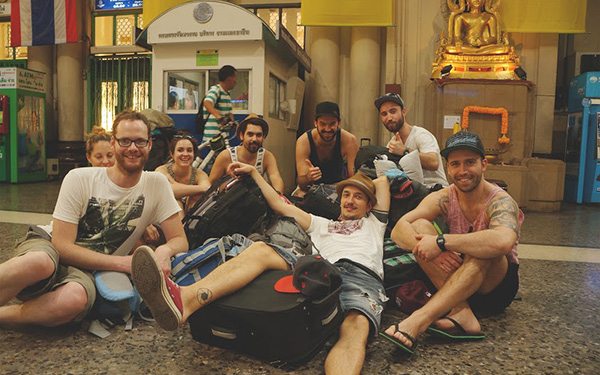The State Railway of Thailand (SRT) has rumbled across the beautiful outreaches of Siam for over 120 years.
Locals use the railway as a low cost travel alternative, and many visitors follow suit. The roaring power of the locomotive creates a soundscape, and as riders roll past a flickering panorama, it is hard to not feel a sense of history and appreciation for the tracks.
However, keeping with history isn’t always a strength. Train users face constant delays, over bookings, and misconceptions. To clear all those up for you I’ve created a guide for train travelers leaving Bangkok.
Where are we going?
It’s easy to pick where the SRT is going to take you.
First, choose your direction.
Second, find your destination on the map.
Third, start packing.
The trains are limited to the mainland, but the tracks are a great way to get you to a ferry connection point.

How much will it cost?
Pricing is based on the intersection of three elements: speed, distance, and comfort.
Special Express trains are the fastest, followed by Express, Rapid, and then Ordinary. Not all trains are available for every destination. Use this fare checking page to determine your options.
Fundamentally, your options are divided into three categories, referred to as classes. Let’s go to school.
- Third Class
This is the most economic choice for travel in Thailand, but it is the hardest class to pass. Third class exposes you to the raw essence of Thai train travel.
Seats are assigned, but the cars are consistently overbooked leaving many in standing room only. At night the floors become big cuddle puddles, where grandmas sleep with children and others (this author included) move off to the hallways to grab some shut-eye.
If you do find yourself in a third class car on an overnight journey fighting for a place to sit, remember that it is polite to wake up a person rather than step over them. Respect goes a long way on a 12 hour trip.
In most cases, travelers will reserve third class for short journeys. A trip to Ayutthaya, for instance, only takes an hour and will cost you just ฿15.
- Second Class
Cushioned bucket seats replace the bench seats of third class, and leg space is almost guaranteed. You may want to upgrade to an air conditioned car with a sleeping bunk. The only trouble you’ll have in second class is keeping yourself occupied.
- First Class
Riders have their own private room that converts into a sleeping area. If you opt for the grand suite, you’ll have no problems feeling superior to the everyone else all the way to your destination.
- Beyond
If you decide to travel with 19 of your closest friends, you might just want to rent out your own car. Prices start at ฿30,000 and include air conditioning. See bougie.
Where do I buy tickets?
The train station.
Seriously, unless you want a handling claim, it’s best to purchase your tickets directly. Using a broker is acceptable only when your destination isn’t on the train line. When buying your tickets through a broker always double check the price of the journey online to avoid price gouging.
How do I get to the train?
Traveling through Sukhumvit and the rest of the greater Bangkok area is, as usual, best done by metered taxi. With all of your bags weighing you down, a bike taxi probably won’t do, and the buses are just too clumsy for such a trip.
If you need to leave during rush hour, you can try the underground MRT. The subway leads straight up to Hua Lamphong (the common name given to Bangkok Railway Station) and only costs as much as the Sky Train above.

When should I get to the station?
Early! Even though the SRT is known for frequently delayed trains, tourists are known for screwing up even more regularly.
Plan to be at Hua Lamphong at least an hour before your departure. A good idea is to take a meal at the station and relax. The station has plenty of dining options and a small grocery store, or you can dine across the street at one of the small cafes overlooking the grand façade of the Bangkok Train Station.
What’s it like on the train?
That’s mostly up to you.
This author’s first 30 minutes were spent in silence, soaking in an unreal sunset that silhouetted passing palm trees, turning them into frozen fireworks against a ruby red sky.
The next couple hours were spent in deep conversation with a Brit living in Pai, and finished up with the last hundred pages of a good book. Bringing friends is a great way to stay occupied, but making them might be even better.
Be open to the experience and let the tracks guide you on to your next adventure…

Featured image is by master_bunk and used under a Creative Commons licence


